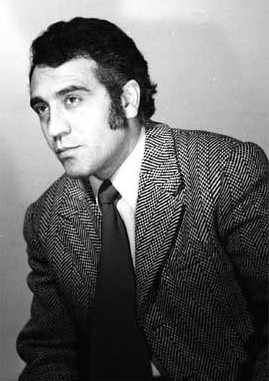|
Overshadowed by Soviet art cinema of the 1960s,
Edmond Keosaian's Elusive Avengers tends to get lost in critical
discussions of the cinema of the period. Yet this color remake of Ivan
Perestiani's 1923 blockbuster Red Imps plays an important role in
the history of the Soviet film industry. The film revived the 1920s
tradition of genre cinema, paying lip service to communist ideology and
promoted Keosaian to the status of a major celebrity. A perfect example
of the red Western, The Elusive Avengers is Keosaian's "cult
classic"—celebrated by the director's fans and appreciated for its
aesthetics of the Western.
 In order to defamiliarize the official historico-revolutionary
film's topoi, Keosaian incorporates Russian Civil War themes into
the iconography of a traditional Western plot. Four teenage friends,
"the magnificent four," get together to protect a village that is being
harassed by a gang of bandits led by villainous Boornush. He has killed
the father of one of the friends, a Red Army commander, providing the
only instance of ideological motivation in the film. The rest of the
film follows the logic of a Western action-adventure without paying much
attention to the ideological motivation of the narrative. The young
friends almost succeed in defeating the bandits in their first battle.
However, the major villain escapes while one of the friends gets
captured and sentenced to death by the bandits. In the final battle,
the remaining "magnificent three" defeat Boornush and save their doomed
friend. In order to defamiliarize the official historico-revolutionary
film's topoi, Keosaian incorporates Russian Civil War themes into
the iconography of a traditional Western plot. Four teenage friends,
"the magnificent four," get together to protect a village that is being
harassed by a gang of bandits led by villainous Boornush. He has killed
the father of one of the friends, a Red Army commander, providing the
only instance of ideological motivation in the film. The rest of the
film follows the logic of a Western action-adventure without paying much
attention to the ideological motivation of the narrative. The young
friends almost succeed in defeating the bandits in their first battle.
However, the major villain escapes while one of the friends gets
captured and sentenced to death by the bandits. In the final battle,
the remaining "magnificent three" defeat Boornush and save their doomed
friend.
The filmmaker draws deeply from the silent cinema
tradition. Endless stunts, long chase scenes, and sight gags filmed
against the backdrop of Western-style locales account for much of
Elusive Avengers' visual appeal. Dialogue is at a minimum, while
the memorable musical score amplifies the effect of fast-paced montage
in chase and fight scenes. After the success of The Elusive
Avengers, Keosaian made two sequels: New Adventures of the
Elusives (1968) and Crown of the Russian Empire, or the Elusives
Again (1971). The Crown of the Russian Empire was filmed at
Grigorii Chukhrai's Experimental Creative Unit, which attempted to
combine state ownership of the film industry with the profit-driven
practices of commercial film production.
Alexander Prokhorov
Edmond Keosaian
Edmond Keosaian (1936-1994) was born in Leninakan,
Armenia. He graduated from the directing department of the State
Filmmaking Institute (VGIK) in 1964 (Efim Dzigan's Workshop). His
Avenger films made him one of the most profitable filmmakers in the
history of Soviet cinema. In the 1970s Keosaian worked at Armenfilm
Studio in Erevan and shot films dealing with issues of national
identity. Keosaian worked at Mosfilm Studio from 1982 until his death
in Moscow in 1994. filmmakers in the
history of Soviet cinema. In the 1970s Keosaian worked at Armenfilm
Studio in Erevan and shot films dealing with issues of national
identity. Keosaian worked at Mosfilm Studio from 1982 until his death
in Moscow in 1994.
Filmography
1962 The Staircase
1963 Three Hours on the Road
1965 The Cook
1966 The Elusive Avengers
1968 New Adventures of the Elusives
1971 Crown of the Russian Empire, or the Elusives Again
1973 Men
1975 When September Comes
1975 The Canyon of Deserted Tales
1978 Star of Hope
1980 The Legend of the Clown
1982 An Oriole is Crying Somewhere
1988 The Ascent |